Chapter 17.46
HEIGHT AND YARD REQUIREMENTS
Sections:
17.46.020 Height measurements.
17.46.070 Corner lot vision triangle.
17.46.010 Purpose.
The purpose of this chapter is to provide regulation for height and lot measurements for building height and yard size. (Ord. 2015-002 § 3 (Exh. 1)(part), 2015)
17.46.020 Height measurements.
The following rules apply to the calculation and determination of height of structures in the city. The intent of these regulations is to provide for compatibility in the measure of structure or building height under a variety of circumstances (e.g., sloped site).
A. General. Height shall be considered the vertical distance from the highest point of any structure to the ground level directly below, except as otherwise provided in this section and shown in Figure 17.46-A.
Figure 17.46-A—Height Measurement
B. Measuring Structure Height on Sloped Lots. Height shall be measured from any point on top of the structure to a line directly below which connects to the opposite perimeter walls, or other perimeter support systems, at the lower of natural or finished grade. All parts of a structure, except for allowed projections specifically listed in this zoning ordinance, shall comply with maximum height limits. See Figure 17.46-B.
Figure 17.46-B—Measuring Structure Height on Sloped Lots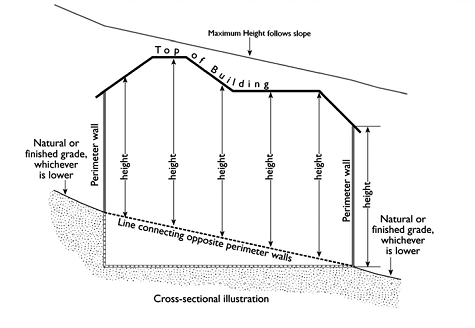
C. Measuring the Height of Structures Located Near Retaining Walls. If any portion of a structure lies within the setback area of a lot and the base of the nearby retaining wall is at a lower elevation than the structure, the height of the structure shall be calculated from the base of the retaining wall (at the lower of natural or finished grade) rather than from the base of the structure wall. See Figure 17.46-C.
Figure 17.46-C—Measuring the Height of Structures Near Retaining Walls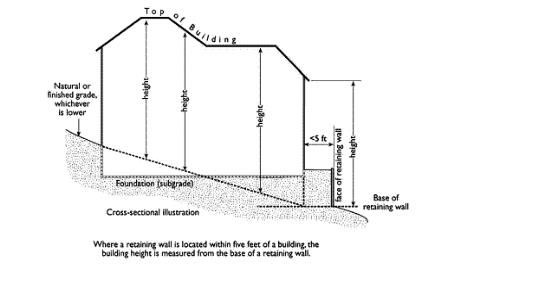
D. Height Limits. Height limits are established throughout this title. Primarily, height limits are listed in Division III, Zoning Districts, Allowed Uses, and Development Standards, where they are listed by zoning district. Additional height limits are established for accessory structures (Chapter 17.42) and fences and walls (Chapter 17.45).
Figure 17.46-D—Height Limit Measurement
(Ord. 2020-002 § 17, 2020: Ord. 2015-002 § 3 (Exh. 1)(part), 2015)
17.46.030 Height exemptions.
A. Architectural Features. In nonresidential districts, chimneys, cupolas, flagpoles, monuments, radio and other towers, gas storage holders, water tanks, and similar structures and mechanical appurtenances may be permitted in excess of building height limits by no more than fifteen feet in industrial districts and no more than ten feet in all other nonresidential zones, provided a use permit is obtained in each case. Towers or other volumes shall not extend for more than twenty feet in any horizontal direction.
B. Rooftop Structures. Rooftop structures such as elevator and mechanical equipment enclosures or roof deck trellises and gazebos may exceed the height limit by ten feet, provided they are set back a minimum of ten feet from building walls and are screened on all sides by a parapet or sloping roof that is architecturally integrated within the building design.
Figure 17.46-C Height Exemptions
(Ord. 2015-002 § 3 (Exh. 1)(part), 2015)
17.46.040 Yard requirements.
The requirements set forth in this section shall be used in interpreting the yard and setback provisions.
A. Front Yard Requirements. Front yards shall be required as follows:
1. In the case of through parcels, front yards shall be provided on two frontages. Where one of the front yards required on a through parcel is not in keeping with the prevailing yard pattern, the average front yard setbacks of the yards provided on adjacent parcels may be substituted for the front yard required.
2. In the case of corner parcels that do not have reversed frontage, a front yard of required depth shall be provided in accordance with the prevailing yard pattern.
3. In the case of reversed frontage corner parcels, a front yard of the required depth shall be provided on one of the two frontages.
4. In the case of corner parcels with more than two frontages, the planning department shall determine the front yard requirements; provided, that at least one front yard shall be provided having the full depth required generally in the district.
B. Side Yard Requirements. Side yards shall be required as follows:
1. In the case of through parcels, side yards shall extend from the rear lines of front yards required.
2. In the case of a corner parcel which does not have reversed frontage, but is adjacent to a parcel with reversed frontage, the rear twenty feet of the side yard fronting the street shall not be less than the front yard required or existing on the adjacent parcel with reversed frontage.
3. In the case of a corner parcel having reversed frontage, the rear twenty feet of the side yard fronting the street shall not be less than the front yard required or existing on the parcel adjacent to the side yard frontage. (Ord. 2015-002 § 3 (Exh. 1)(part), 2015)
17.46.050 Yard measurements.
The methods of measurements set forth in this section shall be used in interpreting the yard and setback provisions.
A. Front Yard Measurements. The depth of front yards shall be measured at right angles to a straight line joining the foremost points of the side property lines. In the case of rounded property corners at street intersections, the foremost point of side property lines shall be assumed to be the point at which the side and front lines would have met without such rounding. Front and rear front yard lines shall be parallel.
B. Side Yard Measurements. The width of a required side yard shall be measured in such a manner that the yard established is the minimum width required by district regulations with its inner edge parallel with the side property line.
C. Rear Yard Measurements. The depth of a required rear yard shall be measured in such a manner that the yard established is a strip of the minimum depth required by district regulations with its inner edge parallel with the rear property line.
D. Special Yards. In those situations where a special yard exists, the zoning administrator shall require a yard with minimum dimensions as generally required for a side yard or a rear yard in the district, determining which shall apply by the relation of the portion of the parcel on which the yard is to be located to the adjoining parcel or parcels, with due regard to the orientation and location of structures and buildable areas thereon.
Figure 17.46-D Yard Area Measurement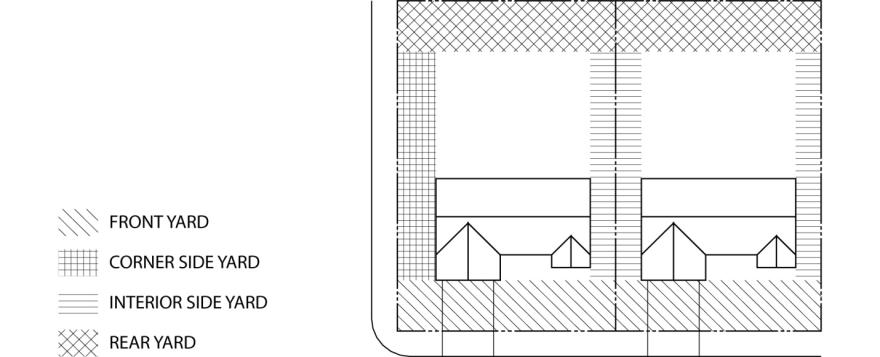
(Ord. 2015-002 § 3 (Exh. 1)(part), 2015)
17.46.060 Yard encroachments.
Yard encroachments shall be allowed as provided in this section.
A. Architectural Features—Cornices and Eaves. Architectural features such as cornices, eaves, and canopies may not extend more than three feet into any required yard or public right-of-way, provided such elements have a clearance of eight feet above the ground. An encroachment permit from the public works department is required for encroachments into the public right-of-way.
B. Architectural Features—Balconies, Chimneys, and Bay Windows. Replacement chimneys, bay windows, balconies, media centers, fire escapes, exterior stairs, and similar architectural features may encroach a maximum distance of two feet into required side yards or three feet into any required rear yard, provided such features shall be at least three feet from a property line. These standards also apply to landings greater than thirty-six inches above grade. Landings that do not exceed thirty-six inches above grade are addressed in subsection C of this section.
C. Porches and Decks. Decks, platforms, uncovered porches, and landing places that do not exceed a height of thirty-six inches above grade may encroach into any front or corner side yard a maximum distance of six feet and project into any rear or interior side yard up to five feet from the property line.
D. Official Plan Lines. Whenever an official plan line, such as a planned future right-of-way line, has been established for any street, required yards shall be measured from such line and in no case shall the provisions of this chapter be construed as permitting any encroachment upon any official plan lines.
E. Corner Parcels. At corner parcels, setback/built-to requirements apply to both street frontages. Corner lot vision triangle standards apply; see Section 17.46.070, Corner lot vision triangle.
Figure 17.46-E - Yard Encroachments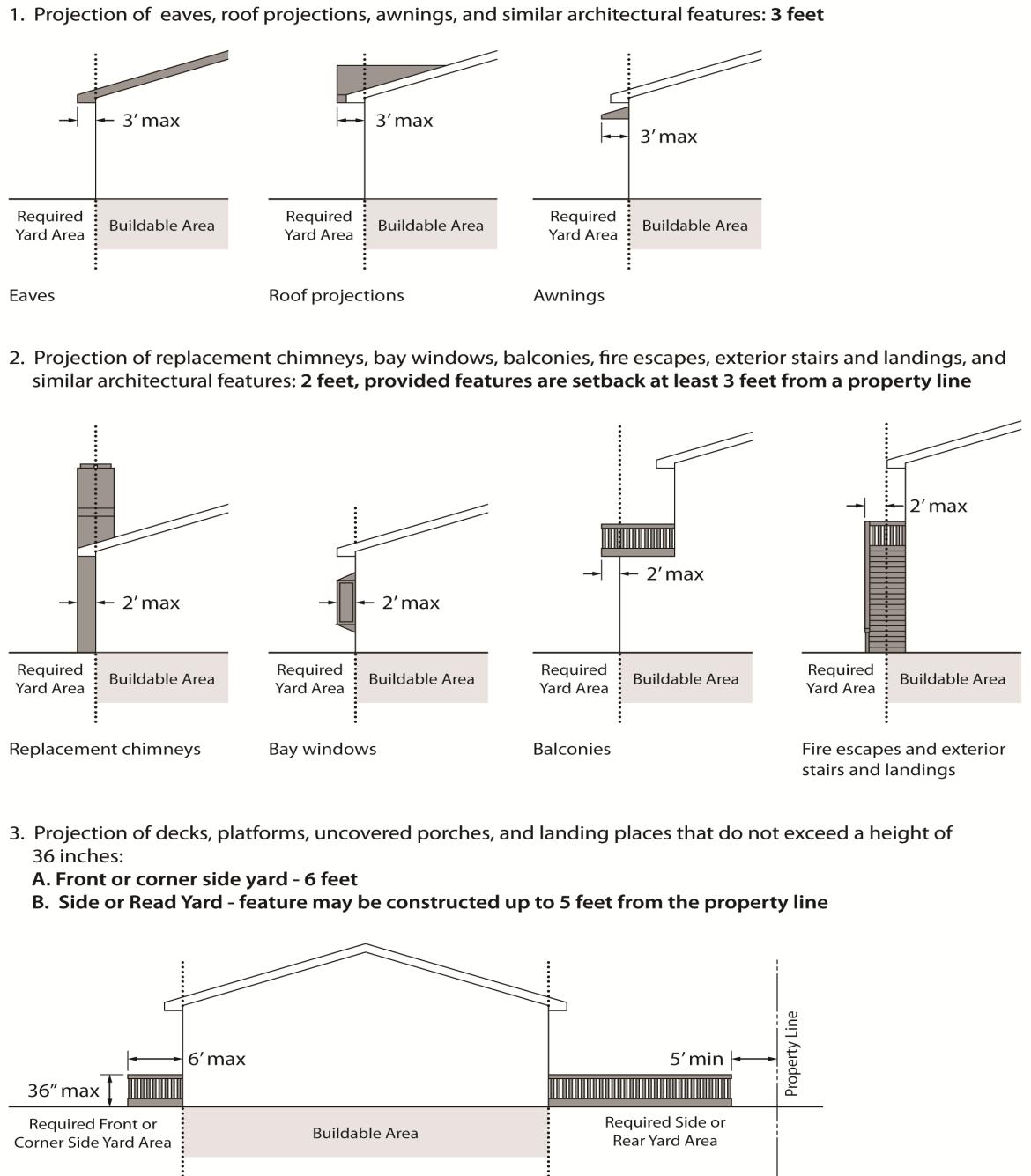
(Ord. 2015-002 § 3 (Exh. 1)(part), 2015)
17.46.070 Corner lot vision triangle.
Vision triangles apply only to corner lots. The boundaries of a vision triangle are formed by drawing lines from the point of intersection of a lot’s street corner property lines to points thirty feet along the two property lines and then connecting the two points with a straight line.
A. Residential Districts. No wall, fence, gate, or hedge higher than three feet shall be erected or maintained on a corner lot in any residential district within the area called the vision triangle.
B. Other Districts. In any district other than a residential district, no wall, fence, gate, hedge, or other obstruction to view shall be erected or maintained between three feet and eight feet above grade on any corner lot within the area called the vision triangle.
C. Planting and Landscape Materials. Planting and landscape materials (except for street trees) shall not exceed three feet in height within the vision triangle area.
Figure 17.46-F Vision Triangle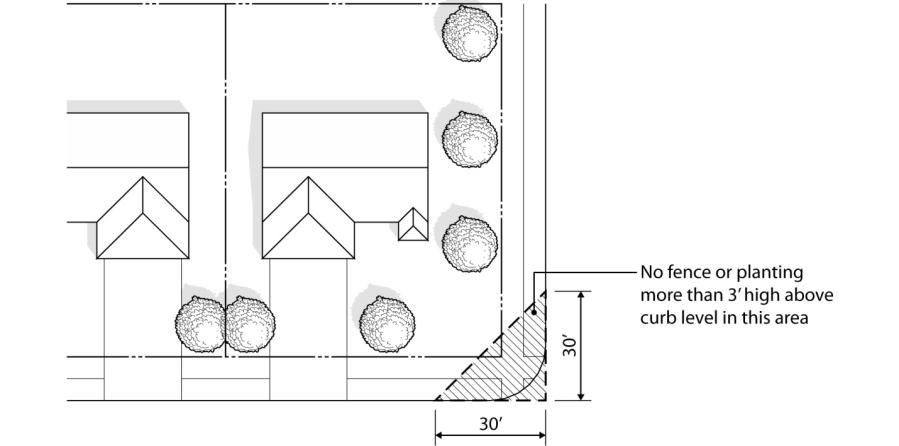
(Ord. 2015-002 § 3 (Exh. 1)(part), 2015)


